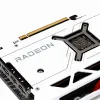Final words and conclusion
The Sapphire Radeon RX 7900 series, particularly the GRE PURE model, incorporates a substantial thermal management system featuring a triple-slot, triple-fan setup. In a controlled case environment under full operational load, this configuration maintains a low sound profile, effectively rendering the card nearly silent. The 7900 GRE model presents a unique position within the 7900 series, as it offers 10-15% lower performance than the 7900 XT and has 20% less memory compared to the XT version. This model appears to target competition with NVIDIA's 4070 Ti and 4070 SUPER in the Western markets, particularly in rasterization performance, where it holds its ground. Currently, the 4070 SUPER is priced at around $649. The 7900 GRE's performance aligns closely with that of AMD's previous 6950XT and 6900XT models. While AMD's graphics cards offer strong overall performance, they tend to underperform in Ultra HD settings, especially with ray tracing, where they still fall behind NVIDIA's more rapid advancements in this technology. The introduction of features like FSR aims to improve AMD's ray tracing capabilities in higher resolutions, though it may slightly compromise image quality.
Cooling & noise levels
Our test shows that gaming will get you an approximate volume level of 38 decibels (perf bios), rendering it relatively muffled. Moreover, the graphics card temperature is 55~60 degrees Celsius depending on BIOS mode. The maximum hotspot temp sits close to 70-75 Degrees C. Our utilization of FLIR imaging did not unveil any worrisome observations in the thermal image but the GPU rear side did get quite warm.
Energy
Remember that the Radeon RX 7900 GRE is a high-end gaming product that still uses much power. Under full load, the baseline editions uses about 260 Watts (average TBP), and the tested card is closer to 300W. This Wattage is directly related to how much heat the GPU, which sits inside a closed case, gives off. Overall, FPS versus Wattage, this card does well.
Coil whine
Every graphics card will inevitably produce a discernible buzzing sound known as coil whine when operating at high FPS. Is it bothersome? It becomes noticeable once you push the frame rates to extremely high levels. In a closed computer case, this noise tends to recede into the background. However, when the chassis is open, the coil whine or squeal becomes audible. Almost all graphics cards exhibit this phenomenon to some extent, particularly when operating at higher frame rates. Despite its presence, we have not noticed it enough to be a noteworthy inconvenience.
Pricing
Admittedly I did not expect to really like something call 'Golden Rabbit Edition' as it's a reshuffled SKU based on the 7900XT. However once I started testing this product I swayed around quite a bit, as at a projected $549 the GRE does offer quite a bit of value for money. I mean the XT model is hovering at $779 and the 16GB memory certainly is plentiful also. That said, it'll remain to be a hard sell with fierce competition from NVIDIA. But the WQHD and Ultra HD domains are perfectly playable with this card.
Suggested Retail Prices for the SAPPHIRE RX 7900 GRE Series:
- NITRO+ RX 7900 GRE: $599
- PURE RX 7900 GRE: $569
- PULSE RX 7900 GRE: $549
Tweaking
The card can be effectively tweaked with ease; however, AMD applied maximum values. One beneficial feature is the power limiter, allowing for a wattage increase of up to +15%. This serves as the initial and fastest option for tweaking. By utilizing this option, you can achieve enhanced performance while staying within the card's default power allocation. Additionally, the boost clock frequency can be set at 2800MHz max. Furthermore, the memory can be optimized to operate at around 18.5 Gbps as it is limited. When all these adjustments are combined, they result in approximately 3-4% additional performance gains in demanding GPU scenarios, measured relative to the baseline performance. Once you apply a bit of undervolting you can stretch the values a bit more and gain an 8-(% performance increase coming from reference, not bad.
Conclusion
The SAPPHIRE PURE Radeon RX 7900 GRE GAMING OC is a graphics card designed with a white chassis and a red LED logo, featuring robust construction and an efficient cooling system. This model offers competitive performance when benchmarked against the NVIDIA GeForce RTX 4070 Series and is equipped with 16GB of graphics memory. The card impresses with its silent operation. Users have the option to further improve performance through regular overclocking and potentially reach a 10% increase with thorough undervolting. Priced at $569, the card offers performance comparable to the 6900 Series, featuring a clock speed range of 2300 MHz and efficient power consumption. Despite a reduction to a 16GB / 256-bit bus, the 16GB memory is currently sufficient for most uses. When compared with competitors, particularly NVIDIA's 4070 SUPER, the card holds its own advantages in rasterization, though it falls short in ray tracing and DLSS 3.5 capabilities. The 7900 GRE HellHound stands out for its quiet operation, design, and performance within AMD's lineup of high-end cards. While it slightly underperforms compared to the 7900 XT, it compensates with better energy efficiency. The card's distinctive all-white design enables it to stand out, and its factory overclocking enhances its performance beyond the standard specifications of the Radeon RX 7900 GRE. Additionally, the SAPPHIRE PURE Radeon RX 7900 GRE GAMING OC variant provides improved performance with its 16GB of VRAM, which is fruitful for future gaming demands. Definitely recommended.
- Download AMD Radeon drivers
- Sign up to receive a notification when we publish a new article.
- Or go back to Guru3D's front page
- Hilbert, LOAD"*",8,1.




